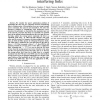Free Online Productivity Tools
i2Speak
i2Symbol
i2OCR
iTex2Img
iWeb2Print
iWeb2Shot
i2Type
iPdf2Split
iPdf2Merge
i2Bopomofo
i2Arabic
i2Style
i2Image
i2PDF
iLatex2Rtf
Sci2ools
ICC
2009
IEEE
2009
IEEE
Maximizing the Sum Rate in Symmetric Networks of Interfering Links
We consider the power optimization problem of maximizing the sum rate of a symmetric network of interfering links in Gaussian noise. All transmitters have an average transmit power constraint, the same for all transmitters. We solve this nonconvex problem by indentifying some underlying convex structure. In particular, we characterize the maximum sum rate of the network, and show that there are essentially two possible states at the optimal solution depending on the cross-gain between the links, and/or the average power constraint: the first is a wideband (WB) state , in which all links interfere with each other, and the second is a frequency division multiplexing (FDM) state, in which all links operate in orthogonal frequency bands. The FDM state is optimal if the cross-gain between the links is above 1/ 2. If the cross-gain is below 1/ 2, then FDM is still optimal provided the average power of the links is sufficiently high. Assuming that < 1/ 2, we can say that the WB state oc...
| Added | 18 Feb 2011 |
| Updated | 18 Feb 2011 |
| Type | Journal |
| Year | 2009 |
| Where | ICC |
| Authors | Sibi Raj Bhaskaran, Stephen V. Hanly, Nasreen Badruddin, Jamie S. Evans |
Comments (0)

